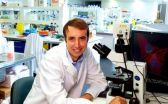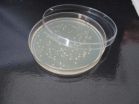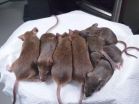(Press-News.org) An Australian researcher has found the third and final missing piece in the genetic puzzle of an unusual form of hemophilia, more than 20 year after he discovered the first two pieces.
Professor Merlin Crossley, of the University of New South Wales, and his international team studied the blood-clotting disorder, hemophilia B Leyden, which is unusual because symptoms improve after puberty.
The results, published in The American Journal of Human Genetics, explain how more than half of the cases of this rare, hereditary bleeding disorder occur, and could help improve understanding of other conditions such as thrombosis.
The find also demonstrates the importance of curiosity-driven research, says Crossley, who is dean of science at UNSW.
"Science is advanced by people who get caught up in puzzles that are important to them and they never forget them. Curious investigators never give up," he says.
Crossley spotted the final genetic clue two years ago, when he was on an aeroplane, marking a young researcher's PhD project. Data in the thesis reminded him of his own PhD project on hemophilia B Leyden, carried out at the University of Oxford in the late 1980s.
People with the disorder have three different categories of mutations in the gene that produces clotting factor IX, which prevents excessive bleeding. Crossley was able to work out how two of them operate, while at Oxford.
He found the two sets of mutations prevent two key proteins from attaching to the DNA, which turns the gene off as a result. Symptoms improve in young men after puberty because a different protein that responds to the hormone testosterone is able to bind to the DNA and boost the gene's production of clotting factor IX.
Crossley, and many other researchers after him, tried to find the key protein associated with the third group of mutations, which accounts for more than half the cases of the disease, but it remained elusive. "Things moved on, but I never forgot," he says.
Two decades later, on the plane, he realised the young researcher was describing a DNA-binding site for a newly discovered protein that had a very familiar ring to it. "I remembered it. It was the same sequence as for the binding site for the third group of mutations," Crossley says.
He joined forces with others at UNSW, including Dr Alister Funnell, and researchers in the UK, New Zealand and Belgium, to show the newly identified protein, ONECUT, was the missing piece in the puzzle of hemophilia B Leyden, which affects about 80 families worldwide.
The original research allowed families to be informed that their children were likely to get better after puberty.
While the new research will not alter the method of treatment for people with hemophilia B Leyden, it could lead to new approaches to regulating genes in general for experimental, or ultimately, therapeutic purposes.
"Understanding the molecular regulation of the coagulation factor IX gene may aid in the development of therapies for other blood-clotting disorders such as thrombosis," says Funnell.
INFORMATION:
Persistence pays off in solving hemophilia mystery, showing curiosity drives discovery
2013-03-07
ELSE PRESS RELEASES FROM THIS DATE:
American Academy of Microbiology releases resistance report
2013-03-07
What do cancer cells, weeds, and pathogens have in common? They all evolve resistance to the treatments that are supposed to eliminate them. However, researchers developing the next generation of antibiotics, herbicides, and anti-cancer therapeutics rarely come together to explore the common evolutionary principles at work across their different biological systems. The new American Academy of Microbiology report "Moving Targets: Fighting Resistance in Infections, Pests, and Cancer" concludes that scientists working on different kinds of treatments have much to learn from ...
Dual systems key to keeping chromosomes intact
2013-03-07
USC scientists have discovered how two different structural apparatuses collaborate to protect repetitive DNA when it is at its most vulnerable – while it is being unzipped for replication.
The centromere—the center of the "X" shape of a chromosome—contains repeated DNA sequences that are epigenetically coded to attract so-called heterochromatin proteins. This protects the structure to ensure that the chromosomes separate properly. If the heterochromatin is lost (due to mutations in the cell), the repetitive DNA becomes vulnerable to rearrangements and recombination. ...
New hypothesis: Why bacteria are becoming increasingly more resistant to antibiotics
2013-03-07
According to his theory, bacteria that are non-resistant to antibiotics acquire said resistance accidentally because they take up the DNA of others that are resistant, due to the stress to which they are subjected.
A University of Granada researcher has formulated a new hypothesis concerning an enigma that the scientific community has still not been able to solve and which could revolutionise the pharmaceutical industry: Why are bacteria becoming increasingly more resistant to antibiotics? His work has revealed that the use of antibiotics can even cause non-resistant bacteria ...
New gender benchmarking study: India is making slow progress in advancing women in S & T
2013-03-07
Delhi, March 7, 2013 - In the first gender benchmarking study of its kind, researchers have found that numbers of women in the science, technology and innovation fields are alarmingly low in the world's leading economies, and are actually on the decline in many, including the United States. India's low overall ranking in the study shows slow progress despite women friendly policies which have been in place for a number of years.
The full gender benchmarking study maps the opportunities and obstacles faced by women in science in Brazil, South Africa, India, the Republic ...
New gender benchmarking study: South Africa ranks low on women participating in STI
2013-03-07
Cape Town, March 7, 2013 – In the first gender benchmarking study of its kind, researchers have found that numbers of women in the science, technology and innovation fields (STI) are alarmingly low in the world's leading economies, and are actually on the decline in many, including the United States. For South Africa, results show that women have more opportunities available to them than ever before, however, their participation in the science, technology and innovation workforce remains low.
The full gender benchmarking study maps the opportunities and obstacles faced ...
Japanese researchers succeed in making generations of mouse clones
2013-03-07
Using the technique that created Dolly the sheep, researchers from the RIKEN Center for Developmental Biology in Kobe, Japan have identified a way to produce healthy mouse clones that live a normal lifespan and can be sequentially cloned indefinitely.
Their study is published today in the journal Cell Stem Cell.
In an experiment that started in 2005, the team led by Dr. Teruhiko Wakayama has used a technique called somatic cell nuclear transfer (SNCT) to produce 581 clones of one original 'donor' mouse, through 25 consecutive rounds of cloning.
SNCT is a widely ...
High BMI linked to heart attack, stroke in young women
2013-03-07
SAN FRANCISCO (March 7, 2013) —A nationwide study of women in Denmark who are of child-bearing age finds that those who are obese appear to have a much greater risk of heart attack or stroke, according to research being presented at the American College of Cardiology's 62nd Annual Scientific Session.
In fact, women with a high body mass index (BMI)—a measure of the body's fat content—that is indicative of obesity were twice as likely as those of normal weight to suffer a potentially life-threatening heart attack or stroke within just four to five years following childbirth. ...
Duckweed as a cost-competitive raw material for biofuel production
2013-03-07
The search for a less-expensive, sustainable source of biomass, or plant material, for producing gasoline, diesel and jet fuel has led scientists to duckweed, that fast-growing floating plant that turns ponds and lakes green. That's the topic of a report in ACS' journal Industrial & Engineering Chemistry Research.
Christodoulos A. Floudas, Xin Xiao and colleagues explain that duckweed, an aquatic plant that floats on or near the surface of still or slow-moving freshwater, is ideal as a raw material for biofuel production. It grows fast, thrives in wastewater that has ...
First discovery of a natural topological insulator
2013-03-07
In a step toward understanding and exploiting an exotic form of matter that has been sparking excitement for potential applications in a new genre of supercomputers, scientists are reporting the first identification of a naturally occurring "topological insulator" (TI). Their report on discovery of the material, retrieved from an abandoned gold mine in the Czech Republic, appears in the ACS journal Nano Letters.
Pascal Gehring and colleagues point out that synthetic TIs, discovered only a decade ago, are regarded as a new horizon in materials science. Unlike conventional ...
Report offers an in-depth examination of health centers' role in family planning
2013-03-07
WASHINGTON and NEW YORK—A report released today by the George Washington University School of Public Health and Health Services (SPHHS) and the RCHN Community Health Foundation offers the first-ever in-depth examination of health centers' role in access to family planning. The report finds that virtually all health centers furnish family planning services to some extent but for both financial and non-financial reasons, only 1 in 5 is able to offer access to the full range of contraceptive services.
The report offers a series of recommendations to strengthen performance, ...


